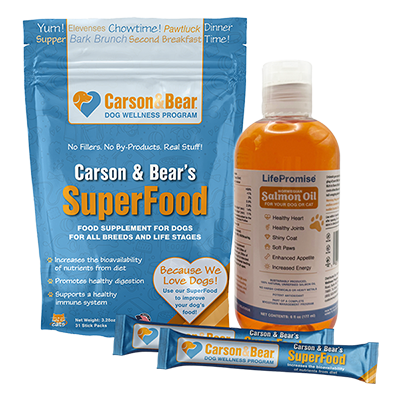As dog parents, making the healthiest choices for our pups is our top priority. Investing in their nutrition is one of the best decisions you can make in caring for your dog, but it’s important to know how to make informed dietary choices. Picking the right food for your dog takes a bit of know-how, but a basic understanding of what’s in it will reflect positively in their overall well-being and longevity, meaning more time together doing the things you love. With so many options to choose from, you’ll need to know how to weed out the bad from good to ensure your dog is being fed the best-in-show food they deserve.
As we work to contribute to a world where healthier pets and people live longer together, we want to provide all pet parents with the information they need to make educated decisions about their dog’s diet. While you want to look for foods that are complete and balanced, there’s more you should look for and here are some tips for finding the best nutrition source on the market.

Focus on the label
Attentiveness to the nutrition label is key when weighing your options. The label provides you with valuable insights about what’s in the bag, its quality, and if it fits your dog’s specific needs for healthy eating. Careful examination of nutrition labels and knowing what to look for will give you peace of mind that your dog is receiving a correct balance of the right nutrients that directly impact their overall health.Dog food ingredients play major roles in their growth, energy level, ability to fight diseases, and more, so it’s important to understand which ones are best for your dog based on their breed, size, stage of life and specific health conditions.

Steer clear of fillers and additives
A major red flag is any excessive use of low-quality fillers such as corn, soy, or wheat. These alternative ingredients are used as an inexpensive way for dog food brands to simply fill the bag versus filling your dog with a nutritious product. Many dogs are sensitive to these ingredients which can cause allergic reactions and digestive issues, and over time can lead to long-term health complications. Common allergic reactions include skin irritation and excessive shedding, while digestive issues may result in diarrhea and vomiting – all unsavory outcomes we don’t want for our pups.
Harmful additives – including artificial coloring agents, flavorings and some preservatives – also offer little-to-no nutritional benefits. Some of these ingredients to be on the lookout for include:
- Menadione: A vitamin K supplement that can damage a dog’s liver, weaken their immune system, and cause skin irritation.
- Ethoxyquin: A synthetic antioxidant outlawed for animal consumption in the European Union known to cause allergic reactions and negatively impact dogs’ major organs and reproductive system.
- Titanium dioxide: A coloring agent that can initiate the early stages of colorectal cancer in animals.
- Butylated hydroxyanisole (BHA) and butylated Hydroxytoluene (BHT): Widely used antioxidants in animal foods that can disrupt hormonal activity and known to be cancer related.
- Carrageenan: A gelling agent used in canned pet foods that can cause or flare intestinal inflammation and induce ulcers.

Seek out nutritious ingredients
Knowing the best ingredients for your dog is just as important as understanding which ones to avoid. High-quality protein sources listed as the main ingredients – such as chicken, beef, lamb or fish – is a great indicator you’ve found a winner. Animal proteins are not only tasty for your dog but are also highly digestible and nutrient dense. They’re also packed with essential amino acids and healthy fats that contribute to a healthier coat, muscle development, and brain function. But don’t stop your evaluation or nutrition research there.
Some other high-quality ingredients that you should be happy to find on the label include:
- Alpha-linolenic acid (ALA), Eicosapentaenoic acid (EPA), and Docosahexaenoic acid (DHA): Omega-3 fatty acids, delivered as fish oils, that improve skin and coat, support brain development of puppies, reduce inflammation, boost the immune system, and support eye, heart and kidney health.
- Proteinate or chelated minerals: These minerals can be identified by their “proteinate or chelate” suffix (e.g., Zinc proteinate) and are more easily absorbed by dogs’ digestive systems. They offer higher bioavailability compared to inorganic minerals that have “oxide” in their name (e.g., Zinc oxide).
- Yucca schidigera, chicory root, and inulin: Prebiotics that contribute to a healthy gut microbiome important for a healthy digestive system.

Don’t be fooled by the marketing mirage
In addition to knowing what ingredients to look for, it’s also important not to get swept up by the fluffy marketing tactics pet food companies use to convince us that their products are the best for our furry friends. While some terms like “natural,” “gourmet,” or “premium” may sound appealing, there are no regulations supporting their use meaning there’s no guarantee these assurances will be reflected in their product. Similarly, statements like “clinically proven” or “scientifically formulated” shouldn’t be trusted at face value without knowing the details of the testing they imply. Finally, some may say “chicken flavor” which essentially means that the food has less than one percent chicken. Instead, look for words like “chicken meal” or “chicken dinner.” When in doubt, always check the protein content on the back of the bag.
You can ensure you’re making the right selection for your dog by looking beyond the buzzwords and happy pups on the front of the product and focusing on the facts of the label and considering the brand’s reputation.

What you can do for your dog’s diet
It’s important to remember that one food doesn’t fit all, and that your dog has its own unique dietary needs that should be served with a variety of high-quality options. Knowledge is key to feeling confident when shopping for your dog, but it’s okay to not have all the answers. When in doubt, be sure to consult with your veterinarian about your dog’s dietary changes to ensure your pup is fueled for fun for years to come.

Like what you learned today? We’ll be sharing more content in the weeks to come. Stay up-to-date by visiting our website or signing up for email updates below.


